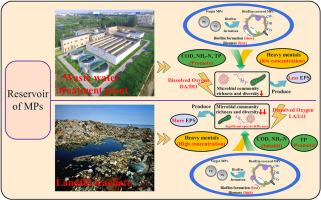Response to microplastics exposure and changes in system performance: a stark contrast between domestic sewage and landfill leachate
IF 7.7
2区 环境科学与生态学
Q1 ENVIRONMENTAL SCIENCES
引用次数: 0
Abstract
Explored the evolution process of representative polyethylene (PE) and polystyrene (PS) in anaerobic/aerobic biological treatment of domestic sewage and landfill leachate, and their effects on system efficiency, sludge performance, and microbial community structure. The results showed that microplastics (MPs) promoted the degradation of COD and NH3-N in domestic wastewater (approximately 99.00 % and 98.16 %), but this result was completely opposite to that in the leachate. The biofilm formation of MPs in leachate was relatively fast in the initial stage, with a biofilm amount (9.39) higher than that in domestic sewage (1.05), showing an “S”-shaped trend, but with large fluctuations over time. The amount of PE and PS biofilm in domestic sewage varied with different oxygen concentrations, but the amount of PS biofilm in leachate was generally higher than that in PE, and PS was more sensitive to biodegradation, while PE had stronger resistance to microbial attacks. Meanwhile, the presence of MPs significantly enhanced the synthesis of extracellular polymeric substances in the leachate (139.81 mg/g MLVSS, anaerobic condition on day 15), increased the concentration of heavy metals in the supernatant (842.91 μg/L, anaerobic condition on day 15), manifested as Mn and Zn. MPs stress led to varying degrees of changes in the structure of microbial communities, but the microbial abundance on the surfaces of PE and PS in the same reactor was similar. Ottowia, unclassifiedd_f_Rhizobiaceae, and Castellaniella were potential MPs degradation genera. The proportion of Thermomonas in the leachate system was about three times that of domestic sewage. The symbiotic mode between MPs and dominant bacteria in activated sludge confirmed the shaping of microbial community structure by MPs. This study contributes to improving the overall understanding of the environmental behavior and risks of MPs in domestic wastewater and leachate biological systems.

对微塑料暴露和系统性能变化的反应:生活污水和垃圾填埋场渗滤液之间的鲜明对比
探讨了代表性的聚乙烯(PE)和聚苯乙烯(PS)在生活污水和垃圾渗滤液厌氧/好氧生物处理过程中的演变过程,以及它们对系统效率、污泥性能和微生物群落结构的影响。结果表明,微塑料(MPs)对生活污水中COD和NH3-N的降解有促进作用(分别为99.00%和98.16%),而对渗滤液的促进作用则完全相反。渗滤液中MPs的生物膜形成初期相对较快,生物膜量(9.39)高于生活污水中的生物膜量(1.05),呈“S”型趋势,但随时间波动较大。生活污水中PE和PS生物膜的含量随氧浓度的不同而变化,但渗滤液中PS生物膜的含量普遍高于PE,且PS对生物降解更敏感,而PE对微生物的抵抗能力更强。同时,MPs的存在显著促进了渗滤液中胞外聚合物质的合成(139.81 mg/g MLVSS,厌氧条件第15天),增加了上清中重金属的浓度(842.91 μg/L,厌氧条件第15天),表现为Mn和Zn。MPs胁迫导致微生物群落结构发生不同程度的变化,但同一反应器中PE和PS表面的微生物丰度相似。Ottowia、unclassifiedd_f_Rhizobiaceae和Castellaniella是潜在的MPs降解属。渗滤液系统中热单胞菌的比例约为生活污水的3倍。活性污泥中MPs与优势菌的共生模式证实了MPs对微生物群落结构的塑造。本研究有助于提高对生活污水和渗滤液生物系统中MPs的环境行为和风险的整体理解。
本文章由计算机程序翻译,如有差异,请以英文原文为准。
求助全文
约1分钟内获得全文
求助全文
来源期刊

Environmental Research
环境科学-公共卫生、环境卫生与职业卫生
CiteScore
12.60
自引率
8.40%
发文量
2480
审稿时长
4.7 months
期刊介绍:
The Environmental Research journal presents a broad range of interdisciplinary research, focused on addressing worldwide environmental concerns and featuring innovative findings. Our publication strives to explore relevant anthropogenic issues across various environmental sectors, showcasing practical applications in real-life settings.
 求助内容:
求助内容: 应助结果提醒方式:
应助结果提醒方式:


